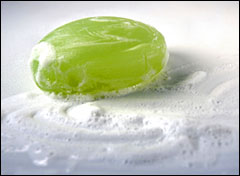Dear Umbra,
Every time I’m lathering with Dr. Bronner’s hemp castile soap, I wonder, what is castile soap? And how is it different from my bar of olive oil-based soap from the farmers market, or my partner’s Dove? Finally, does the ingredient triclosan in antibacterial soap really convert to dioxin in sunlight? And if so, wouldn’t that be more reason (more than, say, the fact that it doesn’t kill more bacteria than other soap) to get this now-ubiquitous stuff off the market?
Cleanly,
Susan
Washington, D.C.
Dearest Susan,
You know I love this kind of thrilling research, so oft delayed by the distractions of modern life. How fondly I recall the day I finally learned the difference between a sofa and a couch, not to mention the time I delved more deeply into glitter. I still yearn to know more about macaroni products, but perhaps they have no relation to major global environmental problems. As regards soap, we can make the argument that using soap is a good, though minor, household move.

You can call me alkali.
Our environmentally based pro-soap argument is this: Soap is a clearly defined, simple product. Whereas over the years the various newfangled ingredients in detergents and cosmetic bars have one by one been revealed as cleansing to the household but polluting to the body and planet (phosphates, nonionic surfactants, fragrances, etc.).
It may be good to go a little further and discuss what, exactly, qualifies as soap.
Traditional soap was made by mixing a fat with lye to produce, as the FDA calls it, alkali-fatty acid compounds. Officially, a product can be called soap if the “bulk of the nonvolatile matter in the product consists of an alkali salt of fatty acids,” if the detergent properties are due to said content, and if the marketing and labeling only claim soapy purposes (as opposed to, say, medicinal or beauty purposes).
Today, many items we think of as soap are in fact synthetic detergents mixed with soap, completely synthetic detergents, or soap mixed with various purportedly beneficial additives — these all are regulated by the FDA as cosmetics or drugs. For example, Dove is a “beauty bar,” not soap. The word “detergent” in general use refers to a non-soap cleanser, made from synthetic ingredients, and containing surfactants as well as sundry other cleansing compounds.
Given all that info, then, what is up with your castile soap? Castile refers to any vegetable-based soap. It’s named after Castile, Spain, where — you guessed it — a famous olive oil-based soap was made. Dr. Bronner’s explains that their solid soaps use sodium hydroxide (aka lye) to saponify (soapify!) the oil, and their liquid soaps use potassium hydroxide. It’s probably not so different from the handmade soap at the farmers market.
As to triclosan, it is an EPA-regulated pesticide used in too many household products, including hand wash, sponges, cutting boards, and more. It is an antimicrobial agent that has been found in breast milk, is toxic to various aquatic organisms, and degrades into one of the less awful types of dioxins. It kills bacteria. It will not, counter to what some companies would like you to believe, protect us against the various viruses that cause the common cold. So, yes, we should stop using it. My favorite Toxics Coalition has a lovely article about antimicrobial products and their dubious necessity.
All in all, carry on with your showering habits and feel free to spread the anti-antimicrobial word.
Sudsily,
Umbra

